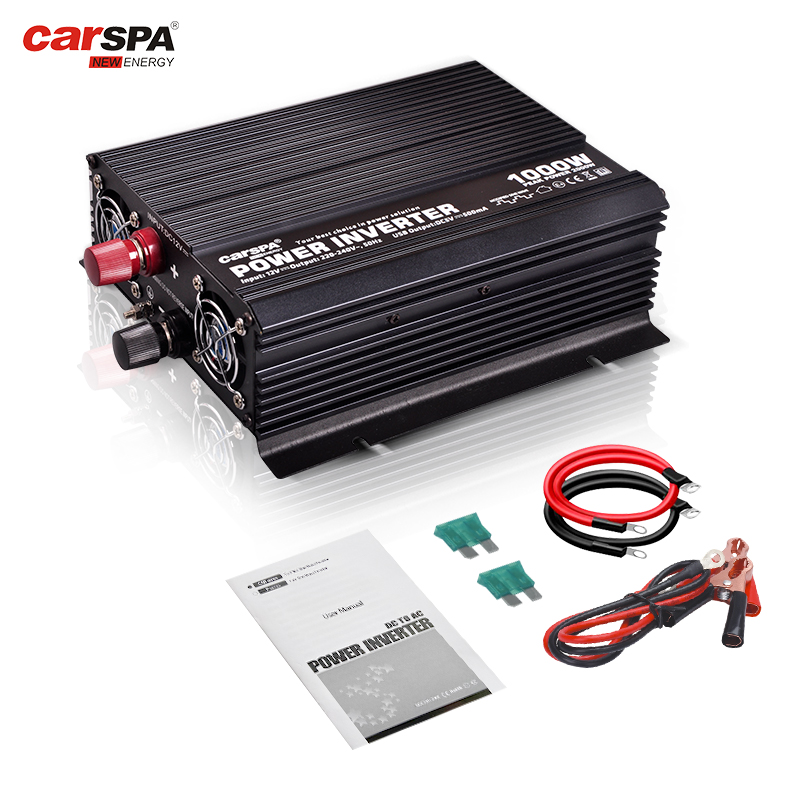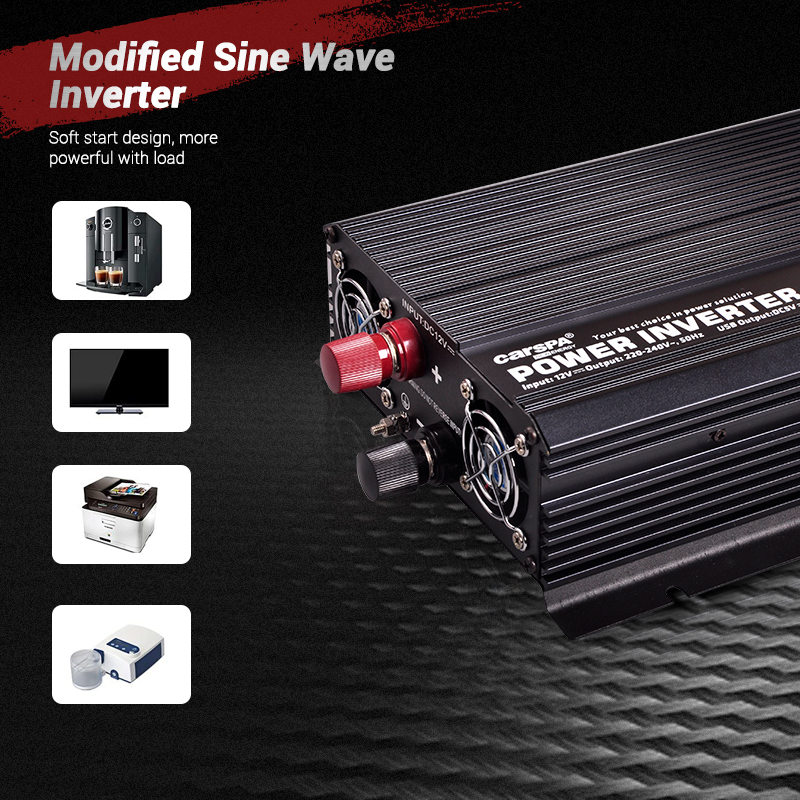The ins and outs of 1000W inverters
With the growing demand for solar systems, RV travel, and off-grid electricity, the use of inverters has become more and more common. In particular, 1000W inverters have been favored by many users with their moderate power and diverse uses. So, do you really know all about 1000W inverters? This article will take you through several key questions to explore all aspects of 1000W inverters in depth.
1. What is a 1000W inverter and how does it work?
A 1000W inverter is a device that converts direct current (DC) to alternating current (AC). Its main function is to convert the DC power in a battery (such as a 12V or 24V battery) into 220V or 110V AC power suitable for most household appliances. Whether it is used to power appliances in an RV trip or in an off-grid solar system, a 1000W inverter is an indispensable key component. So, how does it achieve the conversion of DC to AC?
DC input
The input of the 1000W inverter receives power from a DC power source, which usually comes from solar panels, car batteries, or other renewable energy devices. The input voltage is usually 12V, 24V, or even 48V, depending on your power system configuration.
DC to AC conversion process
Inside the inverter, the electronic circuit converts the DC power into a high-frequency AC signal through the inverter chip and power switching elements. This process usually uses pulse width modulation (PWM) or sine wave modulation technology to simulate an AC waveform close to the mains power.
Output AC power
Finally, the converted AC power will be output through the output of the inverter at a voltage and frequency suitable for household appliances (such as 220V 50Hz or 110V 60Hz). This AC power can directly power the appliances to make them work properly.
For example, when traveling in an RV, you can use an inverter to convert the DC power of the vehicle battery into 220V AC power to power lighting fixtures, refrigerators, coffee machines, and other equipment. This not only improves the comfort of travel, but also makes outdoor activities more convenient.
2. What devices can a 1000W inverter support?
A 1000W power inverter can power a variety of devices, and its application range is relatively wide. But which devices can be operated by a 1000W inverter? This requires considering the rated power and starting current requirements of the device.
Common applicable devices
A 1000W inverter can easily support the following types of appliances:
Small household appliances: such as electric fans, lamps, electric blankets, coffee machines, etc. The power of these devices is usually between 100W and 500W, and a 1000W inverter can easily cope with them.
Electronic devices: such as laptops, mobile phone chargers, tablets, etc. The power of these devices is relatively low, usually between 50W and 150W, and the inverter can provide stable power supply.
Small power tools: such as electric drills, electric screwdrivers, etc. The power of these tools is generally around 500W, and there is no problem using a 1000W inverter for a short time.
Equipment that requires attention
Although the power of a 1000W inverter may seem high, in actual use, some appliances may cause a large load on it, especially those with large starting currents. For example:
Refrigerators and air conditioners: The rated power of these appliances may be only a few hundred watts, but the instantaneous power at startup will greatly exceed its rated value, which may reach 1000W or even more. Therefore, you need to be extra careful when using a 1000W inverter to drive these appliances. It is best to choose an inverter with peak power support.
Microwave ovens and electric water heaters: The rated power of these appliances is usually more than 1000W. Using a 1000W inverter may cause overload. It is recommended to use an inverter with higher power.
Calculate the total power of the equipment
When using a 1000-watt power inverter, you also need to pay attention to the calculation of the total power. If multiple devices are connected at the same time, the total power of all devices cannot exceed 1000W. Otherwise, the inverter will stop working due to overload or even be damaged.
For example, if you want to run a 300W coffee machine and a 200W electric fan at the same time, the total power of these devices is 500W, which is much lower than 1000W and the inverter can handle it easily. However, if you add an 800W electric kettle, the total power will reach 1300W, which exceeds the rated power range of the inverter and may trigger the inverter's overload protection.
3. How does the efficiency of a 1000W inverter affect the user experience?
The efficiency of an inverter refers to the proportion of energy loss in the process of converting direct current to alternating current. The efficiency of a 1000W inverter is usually between 85% and 95%, which means that some of the electrical energy will be lost during the conversion process. The efficiency directly affects the user experience of the inverter and the battery life.
Why is the efficiency of the inverter not 100%?
During the power conversion process, the inverter will have a certain amount of energy loss due to the heat generated by electronic components. These losses mainly come from:
Resistance of the internal circuit: The circuit in the inverter has resistance, and heat loss will be generated when current passes through it.
Switching loss: When the inverter converts current through the power switching element, a small amount of energy will be lost each time the switch action is performed.
Standby power consumption: Even if there is no load, the standby power consumption of the inverter itself will consume some energy.
How to choose an efficient 1000W inverter?
When choosing an inverter, you should give priority to products with higher efficiency, especially those with a nominal conversion efficiency of more than 90%. This can not only reduce power loss, but also extend the battery life and improve the performance of the overall system. Especially in off-grid systems or RV travel, high-efficiency inverters can maximize the use of limited battery energy and provide power for electrical appliances for a longer time.
Tips for improving inverter efficiency
In addition to choosing an efficient inverter, you can also use some tips to improve the efficiency of use:
Avoid long-term no-load operation: The inverter will still consume power when it is no-load. It is best to turn off the inverter in time when not in use.
Choose the right cable: When the inverter is connected to the battery, a cable that is too long or too thin will cause voltage drop and affect efficiency. Therefore, a thicker and shorter cable should be used to connect the battery and the inverter.
Lower the ambient temperature: The efficiency of the inverter may decrease in a high temperature environment. Try to keep the equipment well ventilated and cool.
4. How to judge whether a 1000W inverter is suitable for your needs?
When purchasing and using a 1000W RV inverter, you should not only look at its technical specifications, but also make a comprehensive consideration based on actual usage needs.
Determine the usage scenario
Different usage scenarios have different requirements for inverters. The following are several common application scenarios and their corresponding selection recommendations:
RV travel: If you are an RV travel enthusiast, a 1000W inverter is usually a good choice and can meet the basic needs of most household appliances, such as charging, lighting, and powering small appliances.
Solar off-grid system: For off-grid users of solar systems, a 1000W inverter can be an ideal choice as a backup power source. However, it is necessary to ensure that there is sufficient battery capacity and solar charging capacity in the system to maintain long-term power supply.
Home backup power: In the event of an emergency power outage, a 1000W inverter can provide power for some basic living facilities, such as lighting, mobile phone charging, and small appliances.
Battery configuration considerations
In order for a 1000W inverter to fully function, the selection and configuration of the battery are equally important. Here are a few key factors:
Battery voltage: Most 1000W inverters support 12V or 24V input. Using a 24V system can reduce current, improve efficiency, and reduce cable loss.
Battery capacity: The larger the battery capacity, the more power the inverter can provide. It is recommended to use a battery of at least 100Ah to ensure that the inverter can provide stable power for a long time.
Precautions for using a 1000W inverter
During use, pay attention to the following points to avoid damage to the equipment or safety hazards:
Avoid long-term overload: Try not to exceed the rated power of the inverter. Continuous overload will shorten the life of the equipment.
Check the connection regularly: The connection between the inverter and the battery and the load should be firm. Loose connections can cause voltage instability or even sparks.
Keep good ventilation: The inverter will generate more heat when under high load, and should be placed in a well-ventilated place to avoid overheating.
Conclusion
The 1000W car inverter is a practical and versatile device suitable for various outdoor activities, solar systems and emergency backup power needs. By understanding its working principle, applicable equipment, efficiency and selection tips, you can better use it to improve the convenience of life and the flexibility of power use. Whether in RV travel or in an off-grid solar system, the 1000W inverter can bring you unparalleled power support.







